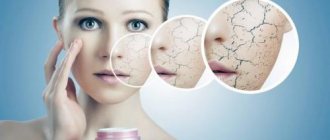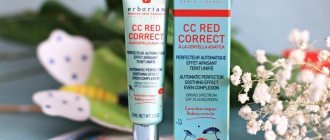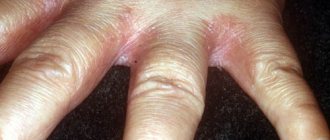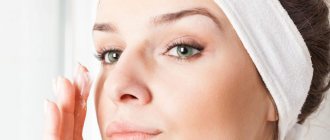Author
: Grachev Ilya Illarionovich
Editor
: Efremov Mikhail Mikhailovich
Date of publication: 09/25/2018 Date of update: 06/08/2020
Very often, the manifestations of psoriasis on the skin of the hands are local in nature, without spreading to the surrounding tissues. With this course, many patients do not pay attention to the rash and do not rush to consult a doctor. But in vain, because in the presence of provoking factors, a “fire” can break out instantly in the form of severe complications, the treatment of which is far from as simple as single psoriatic plaques. Doctors at the Moscow Paramita clinic are well aware of how and how to treat psoriasis on the hands. From this article you can learn how this disease is treated at the initial stage and in severe cases.
Why does psoriasis start on the hands?
Psoriasis on the hands in the form of single regular plaques is only a seemingly local pathological process. In fact, even 1-2 elements of the rash indicate the presence of a chronic inflammatory skin disease. Medicine has not yet been able to unravel all the mysteries of this disease. The exact causes of psoriasis have not been identified. It is only known that the pathological process is based on burdened heredity and immune disorders.
Currently, the genes responsible for the hereditary transmission of predisposition to psoriasis, including on the hands, are being identified and studied. Under the influence of genes, a change in metabolism occurs and a decrease in the content of enzymes that destroy substances involved in inflammatory reactions.
Immunity is also impaired, which leads to a multiple acceleration of cell division in the surface layers of the skin. The cells do not have time to mature when new underlying cells push them to the surface. This is another cause of psoriasis on the hands.
Psoriasis of any localization can spread throughout the body, so do not delay treatment.
See how easily the disease can be cured in 10-12 sessions.
Such changes lead to the appearance of characteristic symptoms of the disease. What does psoriasis look like on the hands? Initially, a scaly spot appears on the hands, sometimes on other parts of the body, which quickly turns into a papule with a raised inflammatory base. The papules grow and merge, forming huge plaques.
But not all genetically predisposed people develop the disease. The reason is the lack of exposure (or minor exposure) to provoking factors. If you avoid these factors, you may never get sick, even if both parents have psoriasis.
Factors that provoke the onset of psoriasis on the hands
Factors that contribute to the development of hand psoriasis are divided into general and local. Common factors include:
- sedentary lifestyle, overweight, obesity;
- hormonal imbalances; the hormonal system is one and a failure in one link will certainly lead to numerous disorders in the body, including metabolic and immune disorders;
- improper irregular nutrition, consumption of large amounts of high-calorie food, meat, sweets;
- bad habits – smoking, alcohol abuse;
- prolonged stress, high mental and physical stress;
- What matters are long-term chronic diseases and foci of infection that contribute to the development of intoxication, under the influence of which metabolism is disrupted.
Red spots on the skin after stress
Diagnosis of skin diseases
Very often, psoriasis on the hands is provoked by the following local factors:
- constant mechanical injury to the skin of the hands - abrasions, scratches, wounds;
- frequent exposure of the skin to various chemicals: household chemicals, industrial hazards, etc.;
- constant exposure to the cold - this leads to spasm of small blood vessels and disruption of skin nutrition; therefore, disruption of metabolic processes is only a matter of time;
- any skin infections - bacterial, fungal, viral.
The skin on the palms of the hands is peeling and peeling: the reasons for this condition
If you find that the skin on your palms is peeling and peeling, you should not immediately panic and look for ways to solve the problem yourself. It’s better to first establish a diagnosis and determine the root cause of this unpleasant problem. After all, sometimes there is no need to treat anything; it is enough to simply get rid of the soap or replace your favorite cream.
Causes of peeling skin on the palms
Other sources of problems of this nature may be the following factors:
- The use of various chemicals, detergents, cleaning products for the kitchen , bathroom, etc.
- Allergenic reactions to cosmetics and, again, household chemicals.
- Lack of certain vitamins , especially: A, E, B.
- Excessive use of antibacterial soaps and alkaline products. After all, their components greatly dry out the skin and can damage its integrity.
- Long courses of drug treatment with antibiotics and other drugs that negatively affect internal organs and skin condition.
- Various dermatological problems. Diseases such as eczema, dermatomyositis , etc.
Making a diagnosis on your own is quite problematic, which is why when you feel an itchy feeling in your palms, unpleasant pain, you should not put off visiting a dermatologist. And it is undesirable to first of all go to a cosmetologist, because he does not treat skin pathologies. Otherwise, there is a risk of making the situation worse. Self-medication and various procedures can only cause harm in the presence of an unidentified disease.
Symptoms of psoriasis on the hands
The disease can begin and progress differently depending on the form. Symptoms of psoriasis on the hands can also vary.
Vulgar form
This is the most common form. On the hands, the skin of the extensor area of the joints, as well as the forearms, wrists, dorsum of the hands, and fingers are usually affected. In the area of the elbows, so-called standby plaques appear on both sides, which can remain in the same state for years without progressing. On the back of the hands, the disease progresses more often, since the skin in these areas is constantly exposed to various influences. Psoriasis often appears on the fingers. In case of damage to the little fingers and thumbs, the risk of injury to psoriatic elements increases.
The first signs of psoriasis on the hands are the appearance of one or more scaly spots, which quickly turn into papules with a raised inflammatory base. If you scratch the top of such a papule, a number of characteristic symptoms appear:
- type of stearin drop - multiple white flakes;
- if you scrape off all the scales, a transparent film will be visible;
- Slightly scraping the film leads to the appearance of droplets of blood on it.
These symptoms are the hallmark of a psoriatic rash. In the future, the primary symptoms of the disease may progress, with the papules increasing in size, merging with each other and forming large plaques, and new elements appear. Possible damage to nails. Over time, the progression stops, after which the recovery process begins: the rash slowly turns pale and disappears.
Exudative form
This form of the disease is less common. The skin on the back of the hands is usually affected. Often this type of psoriasis also affects the fingers. Characterized by the appearance of swelling, exudate on the surface of the rash elements, severe itching and a constant feeling of discomfort. As a result, the scales stick together to form grayish-yellowish crusts on the surface of the papules on the skin of the hands and fingers. In this case, peeling is not very noticeable, but the risk of bacterial infection increases. What exudative psoriasis looks like on the hands can be seen in the photo:
Palm shape
Psoriasis on the palms can occur in the form of plaque-fan-shaped, horny and pustular forms.
The plaque-fan-shaped form is characterized by the formation at the initial stage of rash elements in the form of scaly papules, merging into large plaques. The rashes are localized mainly on the palms and fingers. It often recurs and is difficult to treat. The reason for this is the constant exposure to various external factors. The skin between the fingers is affected. They turn red, swell, and become covered with cracks and scales. Often such rashes spread to the fingertips and nail plates.
The horny form is manifested by dry skin, thickening on the palms, the appearance of cracks and dry calluses.
Psoriasis on the palms of the hands may look like pustules. This is the so-called Barber pustular psoriasis. Purulent blisters appear on the surface of the palms, which can merge with each other, forming purulent lakes. The contents of the pustules are sterile. Photo:
The skin on the palms of the hands is peeling and peeling: treatment with folk remedies
When the skin on the palms of your hands peels and peels, you should follow hygiene rules so as not to introduce infection into open wounds. For this problem, folk recipes are effective. Thanks to masks, compresses, and baths, the condition of the skin improves significantly.
Next, see effective recipes that will help cope with the problem of flaking skin on the palms :
- Using a honey mask you can relieve inflammation of the skin on your palms. To do this, honey is simply applied to the affected areas and then washed off after 25 minutes.
- Any rich cream is suitable for solving the problem of flaking skin on the palms.
- Thanks to baths with soda, you can also significantly alleviate the manifestation of the disease. Take 45 grams of soda, dissolve in warm water, then immerse your palms in the bath for 20-24 minutes, massage them, then wipe and lubricate with moisturizer.
- Baths with vegetable oils . According to herbalists, it is best to use olive oils for such purposes. If you don’t have it, then sunflower will do. Treatment is carried out in the evening. The product is heated to a pleasant warm temperature, the palms are lowered into it for 10-15 minutes. After that, wipe the skin and put on soft, rag gloves for the whole night. In the morning, the condition of the epidermis will improve significantly.
- Using a solution of flaxseeds , you can significantly improve the condition of the skin, so that there are no skin problems, pour 220 ml of water into a container, add 45 g of flaxseeds there, boil until they become thick. When the mixture has cooled down, lubricate your hands.
- A carrot mask also eliminates dry skin on the palms. To prepare the mask, grate a medium-sized carrot, pour milk (45 ml) into a container with carrots, and add 45 grams of ground oatmeal there. Mix everything, make a mask for fifteen to twenty minutes, then rinse everything off and lubricate your palms with olive oil.
These types of treatments are used until the skin problems on the palms of the hands are completely alleviated. The above recipes are best used in combination with other drugs.
Treatment methods for psoriasis on the hands
How to treat psoriasis on the hands? This problem arises immediately after diagnosis. Experts recommend comprehensive treatment, which includes:
- changing lifestyle, daily routine;
- getting rid of bad habits;
- proper nutrition;
Lifestyle recommendations
Patients with psoriasis localized on the hands need to:
- regulate wakefulness and sleep patterns;
- engage in feasible sports; Activities such as outdoor running, swimming, tennis are welcome; avoid contact sports (wrestling);
- important: after playing sports, be sure to take a shower - sweat irritates the skin and can provoke an exacerbation of the pathological process;
- wash only with soft washcloths using hypoallergenic detergents;
- After a shower, apply moisturizer to your body;
- use underwear made from cotton fabrics;
- in the cold season, wear gloves (mittens) with flannel lining;
- Avoid contact with household chemicals and any other chemicals.
Drug therapy
Good to know
- Treatment of psoriasis on the head
- Treatment of psoriasis on the elbows
- Treatment of psoriasis on the legs
- Treatment of psoriasis on nails
- Treatment of psoriasis on the face
- Treatment of palmoplantar psoriasis
In mild cases, psoriasis on the hands is treated locally, using various external agents and procedures. Prescribed:
- keratolytics - medicinal ointments and creams that dissolve surface layers of dead epithelial cells (salicylic acid);
- emollients (tar-based psoriasis ointment);
- synthetic analogues of vitamin D (calcipotriol);
- synthetic analogues of vitamin A (retinoids);
- glucocorticosteroid (GCS) hormones - allow you to treat all forms of hand psoriasis;
- combination products that include GCS + salicylic acid (Diprosalik) or GCS and calcipotriol (Daivobet);
- creams and ointments with active zinc;
- medicinal baths with herbs (celandine, chamomile, calendula).
If the symptoms of psoriasis on the hands do not go away, the disease progresses, and general therapy must be prescribed. It should be carried out in a hospital setting:
- droppers with medicinal solutions that eliminate intoxication;
- injections of drugs that remove toxins (Unitiol, magnesium sulfate);
- desensitizing (eliminating allergies) and sedatives; 1st generation antihistamines (Suprastin, Tavegil) are most suitable;
- glucocorticoids - taken orally or by injection - have a pronounced anti-inflammatory and desensitizing effect, relieve itching;
- cytostatics - drugs that suppress too frequent division of epithelial cells;
- Immunosuppressants are medications that suppress the excessive sensitivity of the immune system.
Unique methods for treating psoriasis on the hands
The Moscow Paramita Clinic is a leader in the treatment of such a complex form of the disease as psoriasis on the hands. Experienced specialists who have undergone all the necessary training in the treatment of this disease try to take an individual approach to the treatment of each patient, using the most effective methods.
- PRP therapy is a method that has been used relatively recently, but has already gained well-deserved popularity, as it is very effective and safe; the method consists of enriching the patient’s blood taken from a vein with platelets and injecting it into the affected areas on the skin of the hands;
- autohemotherapy is a method that has been tested for decades: blood is taken from the patient’s vein and injected intramuscularly; excellent stimulating effect;
- herbal medicine – the use of medicinal plants using modern methods;
- reflexology – exposure to certain points on the body using various methods (acupuncture, massage, cauterization, etc.); exposure to one point or another has a reflex effect on the condition of the skin;
- vacuum therapy is one of the types of reflexology, when certain points and zones are affected using vacuum.
The clinic’s dermatologists prescribe complex therapy taking into account the patient’s age, general condition, the presence of certain concomitant diseases, as well as the nature of the course of psoriasis. As a result of this approach, the patient receives the necessary treatment for psoriasis in Moscow without side effects, which allows him to get rid of the symptoms of the disease for a long time.
To avoid relapses, it is necessary to eliminate the cause of the disease.
Read more about our unique method of treating psoriasis
Patients return to the clinic again and again for maintenance anti-relapse treatment and live for years without exacerbations. In the reviews, they note the high professionalism and attentive attitude of the doctors.
Sign up for a free initial appointment
DRY SKIN OF HANDS IN WINTER
03.Dec.2021
The main thing about hand skin care. In cold weather, you should wear gloves or mittens.
Make it a habit to regularly put them on before going out. Gloves and mittens will protect your skin from sudden changes in temperature and wind. If you always wear gloves or mittens in cold weather, your skin will stop chapping and flaking.
Apply nourishing cream to the skin of your hands.
The most affordable and fastest way to soften the skin is cream, milk or balm. It is recommended to use them at least two or three times a day, and in current circumstances it is absolutely necessary to replenish the moisture balance after each hand washing and use of an antiseptic. For cold weather, rich textures with beneficial compositions are suitable: look for vitamins D and E, ceramides, soothing plant extracts (chamomile, calendula, white or green tea) and oils - shea, coconut, shea and jojoba are especially effective. You can also use Radevit Active - an ointment containing vitamins A, D3 and E on a water-emulsion basis. Vitamin A accelerates regeneration, vitamin D3 improves skin immunity, vitamin E is a natural antioxidant. Radevit Active supports local immunity in the skin and provides a natural antioxidant effect. This is very important for adapting to new climatic conditions and protecting the skin from aggressive environmental influences.
Hand masks.
The easiest way is to apply any nourishing cream to clean hands in a thick layer, massage lightly and put on cotton gloves (special cosmetic ones) for 30 minutes or the whole night - the next morning the skin will be incredibly velvety. You can do a light peeling first if there are no peelings on the skin.
Use a gentle hand sanitizer.
Now you can’t go without a disinfectant, and it’s great that you can sanitize your hands in most public places, including shops, shopping centers and all public places. But inside large containers there may be alcohol diluted with water - such a solution disrupts the skin microbiome and dries it out until burning and wounds appear. If possible, use your own sanitizer and pay attention to its texture and composition.
Be sure to regularly humidify the indoor air.⠀
The heating season has arrived. Naturally, the air becomes drier, which means the epidermis lacks moisture. The situation gets worse if you also turn on an additional heater. A humidifier will solve the problem. Air humidification, by the way, will have a positive effect on your overall health and reduce the risk of viral diseases. The optimal indoor humidity level is 40–60%.
Internal support.
Any problem must be approached comprehensively, so even with active moisturizing, the skin can still remain dehydrated and irritated. Its condition directly depends on nutrition, so in winter it is worth including foods rich in vitamin D and omega-3 in your diet: fish oil, salmon, pink salmon, herring, chum salmon, pike caviar, tuna, beef liver, egg yolk, cow's milk, butter butter, cheese, cottage cheese. They accelerate regeneration processes and prevent the destruction of collagen, a protein that ensures smoothness and elasticity. Remember to drink clean drinking water every day.
B. Shadrina, doctor - dermatovenerologist, Nyagan City Children's Clinic
Stages of hand psoriasis
The disease occurs in alternating phases of relapses and remissions. The course can be severe, moderate or mild. During an exacerbation, the disease goes through several stages. Psoriasis on the hands, stages:
- the initial stage of progression - a psoriatic rash appears, the symptoms of the disease quickly increase;
- stationary – no new elements appear, the rashes do not fade or become smaller;
- regressing - the rash turns pale, swelling subsides, all signs of exacerbation disappear, and gradually only white or brownish spots remain on the skin, which also disappear over time.
Any form of the disease, in the absence of adequate treatment, can be complicated by joint damage and erythroderma - inflammation of large areas of skin with severe swelling and redness.
Itching and peeling of palms
Unpleasant sensations that are caused by internal nonspecific or external irritants of the outer skin are called itching. As a result, a person has a desire to comb or rub a specific area of the skin or mucous membrane. Nerve endings extend to the surfaces of the epidermis, which is why such sensations can arise for a variety of reasons: internal and external. Experts have not yet fully studied the nature of itching. It is assumed that this is a modified pain syndrome that provokes nerve endings. Very often, during itching, the skin on the fingers begins to peel off.
How to eat healthy
Nutrition is of particular importance as it affects metabolism, the disturbances of which underlie the disease. It is useless to treat psoriasis without following a diet. Important: in the patient’s diet, 70% should be products of plant origin and only 30% should be animal products. Recommended to use:
- any fruits and vegetables (fresh, boiled, stewed) except those prohibited;
- fresh juices; Citrus juices are especially useful; lemon juice can be used as a salad dressing;
- more clean water.
Limit consumption (no more than a few times a week):
- lean meat and fish;
- low-fat cottage cheese and fermented milk products;
- cereals;
- some fruits and berries: plums, currants, cranberries, blueberries.
Exclude from the diet:
- fat meat;
- fatty dairy products;
- sweets, baked goods;
- vegetables from the nightshade family: tomatoes, eggplants, hot and bell peppers;
- all spicy, sour, smoked, fried, canned foods;
- drinks: sweet soda, cocoa, strong coffee, tea, alcohol.
Treatment of psoriasis on the hands with folk remedies
Folk remedies are widely used in the treatment of psoriasis on the hands. Celandine is especially often used for this purpose. For example, a serum infused with celandine helps a lot.
You need to take a glass of crushed fresh celandine herb, wrap it in a cotton napkin, tie it, put it in a 5-liter glass jar, fill it with three liters of whey, add 200 g of sugar, 20 g of sour cream and leave in a warm place for 15 days: during this time the whey will ferment ; this serum should be filtered and taken 70 ml in the morning 30 minutes before meals; store in a cool place; perfectly removes toxic substances, cleanses the body, activates metabolism; the symptoms of the disease go away.
Cracks and itching of the skin of the hands due to illness
Disruption of internal organs and inflammatory processes are reflected in the palms. If the skin on your hands is dry and cracks until it bleeds, and the affected area itches, but external factors are excluded, perhaps the body is signaling that there are serious problems. Among them:
- Diabetes mellitus type 2. The skin becomes rough and dry, cracks appear between the fingers. Due to the partial loss of sensitivity in diabetes mellitus, wounds do not hurt very much, but this should alert you. If peeling, itching, or cracks are noticeable between the fingers of an adult, the doctor should tell you how to treat it. After all, first of all, the course of therapy should be aimed at normalizing blood glucose, and accompanying measures should be taken to heal wounds.
- Fungus. There is a high probability of infection by microorganisms in public places with high humidity. Spores easily travel through the air, so they can “settle” on your hands anywhere. The main symptoms are redness and peeling of certain areas of the palms, cracks on the fingers at the edge of the nail, on the folds of the phalanges.
- Eczema. This is a skin disease that causes damage to the epidermis and severe itching. Eczema can be wet or dry. In the first case, the blisters burst, releasing serous fluid. Then dry crusts form in this area. The skin on the hands cracks and itches badly, takes a long time to heal, causing physical and mental suffering to the patient.
- Neurodermatitis. Along with increased nervous excitability, itching and peeling appear on the hands. With a complex course of the disease, the integrity of the epidermis may be damaged due to severe scratching. Without solving the psychological problem, you won’t be able to get rid of the accompanying symptoms; you can only temporarily reduce the discomfort.
- Psoriasis. Small rashes initially appear on the hands: redness, peeling, blisters. After detachment, plaques with a smooth surface are visible. With psoriasis, the skin between the fingers and toes cracks. The disease worsens due to nervous stress, lack of nutrients, and overwork.
- Scabies. Both adults and children are susceptible to parasite infection. The lesion on the hands is noticeable first, and if left untreated, it quickly spreads to other areas. Sores on the hands that appear from bites itch and crack, carrying the risk of another infection. The itching gets worse at night.
- Scarlet fever. On the 4-5th day of the disease, the epidermis on the hands peels off and flakes off, especially the fingertips are affected. This symptom clearly indicates the disease, because the primary small rash is not always noticeable.
- Syphilis. Nodules on the hands do not appear immediately. These are pronounced signs of secondary syphilis, preceded by malaise, migraine, and fever. Small sores on the hands itch and crack. They protrude above the skin, do not unite with each other and gradually disappear on their own.
- Avitaminosis. A deficiency of useful elements makes the body unable to resist various infections and prevents the full functioning of all body systems. In addition to general malaise, the first thing noticeable is the dryness of the epidermis, the skin on the fingers cracks, and the whole body itches. The problem is serious and requires an immediate solution.
Read also: A rash on an adult’s body itches: how to treat rashes with itching
Prevention of psoriasis on the hands
Prevention of the disease includes patient compliance with recommendations on daily routine, skin care and nutrition.
Psoriasis on the hands is best treated in the early stages of the pathological process. It is impossible to completely cure this process, since under the influence of any factors a relapse may begin. But if maintenance treatment is carried out periodically, remission for a long time is quite possible. At the same time, the person lives life to the fullest and does not remember relapses.
Peeling and peeling skin on the palms of the hands: prevention
If you have a tendency to dry skin on your hands and palms and sometimes there are periods when the skin on the palms of your hands peels and peels, then you should take a number of preventive measures that will allow you to protect your delicate skin from aggravations.
Do the following:
- Wash your hands regularly, using only gentle hygiene products. Try to wash them only in warm water.
- Before going outside, be sure to dry your hands so that they do not dry out or become chapped.
- In winter, lubricate the skin of the palms of your hands with fatty creams, and in the evening make masks for the skin of your hands, try not to go out into the cold without gloves.
- If peeling of the palms has already begun, then remove dead skin cells with scrub creams.
- When you have to use chemicals, wear rubber gloves.
- Try to massage the skin of your hands daily in the evening with gentle movements to improve blood flow, which in turn improves the regeneration of the skin.









